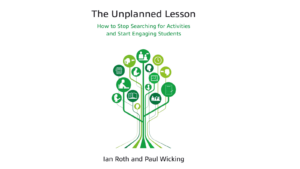The Book of Pronunciation
When I was first doing my CELTA course in Seoul, South Korea, I learnt lots of new techniques and ideas which I could use in my English lessons. However, when I first encountered the phonemic chart during the course I felt quite self-conscious. I was unwilling to incorporate pronunciation and the teaching of the phonemic chart into my class. A few years ago, I went to a workshop by Adrian Underhill and he introduced the chart to all attendees. It was at this point, while watching Adrian demonstrate practical ideas and methods, that I decided to use and incorporate the phonemic chart into lessons. I went home and decided to make phonemic charts for all my students as well as one to put up on the whiteboard. It did take a while to actively teach pronunciation in class but I am now more comfortable teaching this skill to my learners.
One book that I have recently purchased to help me on my quest to incorporate practical pronunciation techniques, is “The Book of Pronunciation: Proposals for a practical pedagogy” by Jonathan Marks and Tim Bowen. The book is published by DELTA Publishing and is a part of the DELTA Teacher Development Series, with it first being published in 2012. This book follows the wonderful recognised formula of the DELTA Teacher Development Series with this publication being split into three catergories: Part A – the introduction of pronunciation, Part B – practical ideas to use in class and Part C – additional ideas to consider when teaching pronunciation with learners.
The first part in the book offers the reader with some general questions or statements to consider and reflect upon with the teaching of pronunciation. This includes pronunciation learners should aim to achieve, why teachers should focus on pronunciation during lessons or whether pronunciation is easier with monolingual or multilingual learners in the same classroom. The authors offer some additional thoughts (notes, tips, etc.) on the various statements and highlighted questions. This area develops the reader’s understanding in relation to pronunciation, such as explanations of fricatives, plosives, etc, as well as further information on more learner related issues, consonant clusters, word stress or connective speech. Part A is extensive and readers, should they be able to dedicate the time to reading this area, will develop their awareness of pronunciation and the terminology related to this area, as well as learn more about learner-related issues regarding pronunciation as well as the practical aspects of teaching pronunciation in the classroom. The phonemic chart is introduced nearer the end of Part A in the book with detailed explanation of how the chart represents a ‘map’ between the movement and sound produced in the mouth. The authors also provide a detailed list between the various vowels, consonants and diphthongs with the corresponding spelling in English.
The second part of the book, as expected in the DELTA Teacher Development Series, offers some lesson ideas to incorporate the teaching of pronunciation in the language classroom. Lesson ideas in Part B are well-organised and naturally develop to support teachers willing to incorporate pronunciation with these recommended lesson ideas that focus on six chapters: “Introducing … “, “Sounds”, “Sounds and spelling”, “Word stress”, “Connected speech” and “Stress, rhythm and intonation”. The first chapter in Part B, “Introducing …”, contain 8 lesson ideas which could be used by readers, with these being a focus on pronunciation, the phonemic chart, syllables to name just a few. The following chapter, “Sounds”, which have 24 lesson ideas, focus on certain sounds within English. “Sounds and spelling” looks at the association between the spelling of particular words and the sounds created. One thing that I like about this chapter is that there is a wonderful lesson that looks at acronyms in English and how these are used or pronounced in the language. The final three chapters in Part B – “Word stress”, “Connected speech” and “Stress, rhythm and intonation” – are obviously self-explanatory and focus on these areas of pronunciation.
There are some fantastic lessons in the final three chapters and I have my favourite activities that I like to incorporate into new classes. The authors suggest some wonderful activities which could be used within lessons which involve a coursebook or those that could be developed as part of an overall lesson. The wealth of ideas or suggested activities within all these chapters supports readers who are wishing to include a focus on pronunciation – whether it is a whole lesson focus or a part of a shorter lesson focus. You would be hard pressed to not find activities to suit your class or learners.
The final part of the book, Part C, which focus on “More …”, contains three chapters. The first chapter, “More … about pronunciation”, offers readers the chance to test their own personal knowledge of pronunciation, connective speech as well as phonemic transcription errors which readers could correct. The second chapter, “More … about learners”, inspires readers to conduct possible research to improve personal understanding of learner pronunciation as well as accent with some suggestions tasks to do. The final chapter in Part C, “More … about teaching”, offers some ideas and thoughts on teaching and responding to a pronunciation-related issues with some ideas on how best to respond to some of these area. For example, the authors consider backchaining, which is a common technique in class, as well as the use of tonic prominence possibly changing if backchaining is not used correctly. Nearer the end of the book, there is a focus on writing and the representation of pronunciation on the whiteboard, the use of the spoken language the focus on weak forms as well as the use of the learner’s first language in the classroom and this impact on pronunciation. Furthermore, there is a wonderful focus on teacher training with the authors offering 25 questions which could be used during training sessions to prompt discussion and debate among attendees. Finally, there is additional reading for teachers who would like to develop their background knowledge of pronunciation and language acquisition.
This book is quite condensed, with a great many ideas for developing and incorporating pronunciation in the classroom, and requiring the reader to select activities to use in lessons. It is, however, an invaluable book packed with resources. “The Book of Pronunciation” will help develop your confidence and ensure that you are fully prepared to incorporate pronunciation into your lessons. If you are too self-conscious and unwilling to incorporate pronunciation into lessons, buy this book. You won’t be disappointed.





One Response
Pete Pun
a good overview Martin. Thanks for introducing me to this book last year - it is my favourite resource now!
01/09/2015